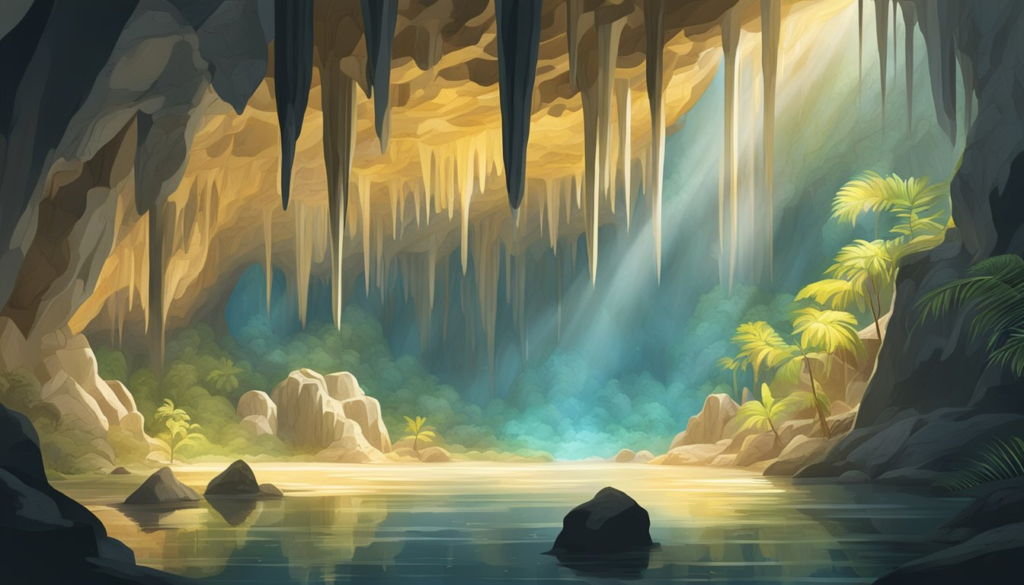The Caribbean is not only known for its picturesque beaches, vibrant cultures, and lush landscapes but also for its fascinating subterranean world—its limestone caves. Carved over millennia, these cave systems hold a rich geological history and support a diverse range of ecosystems that are often overlooked. From the intricate rock formations to the unique species that dwell in their depths, Caribbean limestone caves offer a glimpse into the hidden wonders of the region.
This article delves into the formation, significance, and ecological importance of these limestone caves and highlights some of the most notable cave systems in the Caribbean.
How Caribbean Limestone Caves Are Formed
Caribbean limestone caves are primarily formed through a natural process called karstification. This occurs when slightly acidic rainwater, enriched with carbon dioxide, seeps into the ground and begins to dissolve the calcium carbonate in limestone. Over time, this chemical reaction erodes the rock, creating expansive caverns, sinkholes, and intricate cave networks.
Stages of Cave Formation
- Rainwater Absorption: Rainfall in the Caribbean absorbs carbon dioxide from the atmosphere, forming a weak carbonic acid solution. As this acidic water infiltrates the ground, it comes into contact with limestone rock formations.
- Erosion and Dissolution: The acidic water gradually dissolves the limestone, enlarging cracks and fractures in the rock over thousands or millions of years. This process forms underground chambers, tunnels, and cave systems.
- Cave Decoration: Inside these caves, stunning formations such as stalactites, stalagmites, and columns begin to take shape. These formations occur as water drips into the cave, leaving behind small deposits of calcium carbonate. Over time, these deposits accumulate, creating intricate structures that hang from the ceiling (stalactites) or rise from the floor (stalagmites).
Karst Landscapes
The regions in the Caribbean where limestone caves are found are often part of karst landscapes—topographies shaped by the dissolution of soluble rocks such as limestone. In these landscapes, one can find not only caves but also sinkholes, disappearing rivers, and natural springs. Countries like Puerto Rico, Cuba, and Jamaica are known for their dramatic karst landscapes, which are often home to some of the Caribbean’s most impressive cave systems.
Unique Ecosystems Within Caribbean Limestone Caves
While caves may seem inhospitable, they harbor unique ecosystems that have adapted to the extreme conditions found underground. Without sunlight, food is scarce, and organisms living in caves must rely on specialized adaptations to survive. These environments are often described as oligotrophic, meaning they are low in nutrients and energy sources.
Cave-Dwelling Species
The species that inhabit limestone caves are known as troglobites—organisms that have evolved specifically to live in caves. Many of these species have lost their pigmentation and eyesight, as they no longer rely on vision in the darkness of their environment. Instead, they have developed heightened senses of touch and smell to navigate and find food.
Some of the most fascinating cave-dwelling species include:
- Blind Fish: Fish species found in submerged caves, such as the Cuban blind cave fish (Lucifuga subterranea), have completely lost their eyesight and pigmentation. These fish rely on sensory adaptations to detect movement and vibrations in the water.
- Cave Crabs: The white cave crab (Munidopsis polymorpha), found in blue holes and underwater cave systems, has similarly evolved to live without eyesight. These crabs have highly sensitive antennae that help them navigate and search for food in the pitch-black environment.
- Bats: Bats are one of the most common inhabitants of Caribbean limestone caves, using them as roosting sites. Bat colonies, such as those of the Jamaican fruit bat (Artibeus jamaicensis), are vital to the cave ecosystem, as their droppings (guano) provide a nutrient-rich food source for many cave-dwelling species.
Nutrient Sources in Caves
Since sunlight cannot penetrate the depths of most caves, traditional food webs that rely on photosynthesis are absent. Instead, the energy in cave ecosystems often comes from external sources. The most common source of nutrients in caves is organic material that washes in from outside or is introduced by animals, such as bat guano.
In some underwater cave systems, nutrients may be carried in by water currents, supporting a small but diverse range of marine species. These ecosystems are typically fragile and depend on a delicate balance of nutrient input and the presence of species that can break down organic material.
Notable Limestone Caves in the Caribbean
The Caribbean is home to some of the world’s most impressive limestone caves, many of which are renowned for their geological beauty, historical significance, and ecological importance. Below are a few of the most notable cave systems in the region.
1. Cueva Clara, Puerto Rico
Located in the Camuy River Cave Park, Cueva Clara is one of the largest and most well-known limestone caves in Puerto Rico. This massive cave is part of an extensive underground river system, with the Río Camuy carving through the limestone over millions of years. Visitors can explore vast chambers adorned with stalactites and stalagmites, while underground rivers flow beneath their feet.
In addition to its geological beauty, the cave system is home to various bat species and other troglobites. The cave’s ecosystems rely heavily on the presence of bats, whose guano serves as a primary food source for many cave-dwelling invertebrates.
2. Green Grotto Caves, Jamaica
The Green Grotto Caves, located on Jamaica’s north coast, are rich in both geological and cultural history. These caves were used as hideouts for runaway slaves and smugglers during the colonial period. Today, they are a popular tourist destination, known for their dramatic limestone formations and underground lake.
The caves are home to several species of bats, and their pristine pools provide habitat for small fish and invertebrates. The Green Grotto Caves offer a glimpse into Jamaica’s natural and historical heritage, making them a significant site for both ecology and tourism.
3. Bellamar Caves, Cuba
Discovered in the 19th century, the Bellamar Caves in Matanzas, Cuba, are among the oldest tourist attractions in the Caribbean. The caves stretch for over 3,000 meters, with dazzling formations of stalactites, stalagmites, and flowstones. The most famous chamber, known as the Gothic Hall, is renowned for its impressive stalagmite formations.
Bellamar Caves also serve as a habitat for several species of bats and invertebrates, making them important not only for tourism but also for the conservation of cave-dwelling species.
4. The Bahamas Blue Holes
The Bahamas are famous for their blue holes—deep, water-filled sinkholes that open into extensive underwater cave systems. These caves are often partially or fully submerged, making them a unique environment where marine and terrestrial ecosystems converge.
Blue holes are home to a wide variety of marine life, including blind fish, cave shrimp, and crabs. The nutrient-poor waters of the blue holes have forced these species to adapt to extreme conditions, making them some of the most fascinating creatures in the Caribbean.
Ecological and Cultural Significance of Caribbean Limestone Caves
Caribbean limestone caves are not only important for their geological and ecological features but also hold significant cultural value. Many of these caves were used by indigenous peoples for ceremonial purposes, as shelters, or as burial sites. The Taino people, for example, used caves in Puerto Rico and the Dominican Republic for religious rituals, leaving behind petroglyphs and artifacts that provide insight into their culture.
Today, caves continue to be important cultural landmarks and popular ecotourism destinations. The biodiversity found within these caves, along with their historical significance, makes them valuable for both scientific research and conservation efforts.
Conservation Challenges
Despite their ecological importance, limestone caves face several threats, including pollution, habitat destruction, and unsustainable tourism practices. Many cave ecosystems are extremely fragile, and even small changes in their environment can have a lasting impact on the species that live there.
Efforts to protect these caves include establishing protected areas, promoting sustainable tourism, and conducting scientific research to better understand the dynamics of cave ecosystems. Protecting these caves is crucial for preserving both their biodiversity and their cultural heritage.
Conclusion
Caribbean limestone caves are hidden gems that offer a glimpse into the region’s geological past and ecological present. These caves, formed over millions of years, are home to unique ecosystems that have adapted to life in darkness, relying on specialized traits to survive. From bats and blind fish to cave crabs and ancient rock formations, the biodiversity found within these caves is both fascinating and fragile.
As we continue to explore and appreciate the wonders of these subterranean worlds, it is essential to prioritize their conservation. Protecting the ecosystems and cultural heritage of Caribbean limestone caves will ensure that future generations can experience the beauty and mystery of these hidden wonders.
FAQ
What is a limestone cave, and how does it form?
Limestone caves form through the process of karstification, where acidic water dissolves limestone over time, creating underground chambers and tunnels. This process can take millions of years, resulting in intricate cave systems.
Which Caribbean islands have notable limestone caves?
Caribbean islands such as Puerto Rico, Cuba, Jamaica, and the Bahamas are known for their extensive limestone cave systems, including Cueva Clara, Green Grotto Caves, Bellamar Caves, and Bahamas Blue Holes.
What species live in Caribbean limestone caves?
Caribbean limestone caves are home to a variety of species, including bats, blind fish, cave crabs, and other troglobites. These species have evolved to survive in the dark, nutrient-poor environments of caves.
Can you visit limestone caves in the Caribbean?
Yes, many limestone caves in the Caribbean are open to the public for tours and exploration. Some popular destinations include Camuy River Cave Park in Puerto Rico and the Green Grotto Caves in Jamaica.
Why are Caribbean caves important for biodiversity?
Caribbean caves provide unique habitats for species that are specifically adapted to life underground. These caves support diverse ecosystems that are critical for maintaining biodiversity in the region.
How can we protect limestone caves in the Caribbean?
Protecting limestone caves involves establishing protected areas, promoting sustainable tourism, and supporting scientific research to better understand and conserve cave ecosystems.

